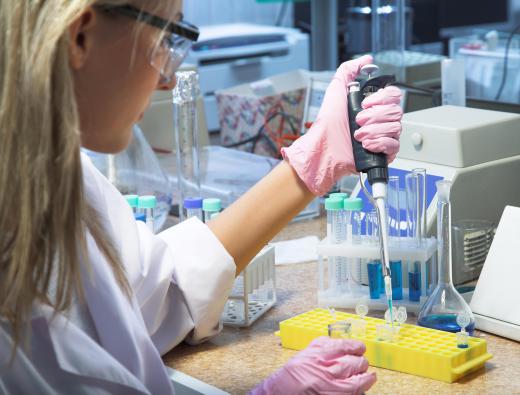What is Zymography?
Zymography is a technique performed by biochemists in which particles are dispersed using an electrical charge in a process known as electrophoresis. Specifically, the process uses a substrate in which an enzyme will react through polymerization with a polycrylamide gel, a water-based solution made from toxic materials. This zymogram gel is known as sodium dodecyl sulfate polyacrylamide gel (SDS-PAGE).
A biochemist performing zymography will prepare the zymogram gel using the electrophoresis method. Usually this method is done in conjunction with boiling or reducing the gel. However, in zymography, the SDS-PAGE gel is kept intact. After this step, the SDS portion of the compound is removed using a material known as a Triton X-100™, an oxidization detergent from the BASF™ company. This material is kept at 98°F (about 37°C) for a length of time in an advanced incubator. A biochemist will then stain the remaining material using either a black or blue compound. This enables a researcher to identify where and how digestion occurs by the enzymes in the substance.

While the SDS-PAGE gel is the most commonly used substance in zymography, other types of material can be used to identify the digestion rate and capability of an enzyme. Many times this includes the addition of a starch film to help the visual identification process.
Biochemists and biomedical engineers commonly use this process in an effort to learn about new forms of enzymes. By defining the rate of digestion and movement patterns of an enzyme, the different properties of human and animal proteins can be identified. This is used for certain genetic research and analysis as well as drug and medicine applications.
The process of zymography must be handled with care. While it can principally be done with minimal safety precautions, any scientist or researcher handling the materials must be sure to avoid physical contact. Both the Triton X-100™ detergent and the SDS-PAGE gel can be highly toxic to the skin.
There are a number of enzymes that do not respond as expected to this process. For example, the D. melanogaster digestive glycosidases can survive reduction processes in other types of digestive examination. In addition, it will survive the heating process all the way up to 122°F (about 50°C), well past the level needed in the traditional zymographical process. When an enzyme survives the process without fully digesting the SDS-PAGE gel, an increased band resolution is seen on the final stages. This can cause problems with obtaining correct results from the zymography process.
AS FEATURED ON:
AS FEATURED ON:











Discussion Comments
@everetra - I think a lot of the process of discovery in biochemistry involves reactions. Take two or more substances, combine them some way, and then see what kind of reaction you get.
The reaction will tell you what you’re dealing with. With enzymes, if I recall correctly, the reaction gets speeded up which is why they’re needed to break down protein.
Enzymes are the catalysts; that’s what my nutrition training tells me, I admit I’m not up too much on the techniques that biochemists use. From what I read here, however, it appears that they are watching what the enzymes do and seeing if new ones get created.
I’ve noticed that many times doctors and scientists like to stain substances with dyes and stuff in order to track them in the body.
I know that they use that with cardiac patients where they will insert a dye into the body and use it to track its movement through the bloodstream.
I see that they use a similar method here in zymography, where they are staining the substances in order to track them and see how enzymes do their thing.
I admit that the article is a bit heady, but that was just something that caught my attention. I think that is a very clever technique.
Post your comments